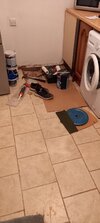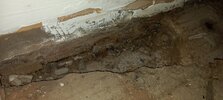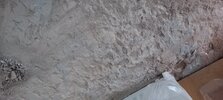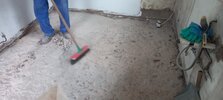Hi all,
Me again. Problem #3,678 in this ongoing renovation.
I'm getting the kitchen replaced in a few weeks. Part of the deal is that I'm removing all the units and existing tiles/adhesive on the floor. The tiling in there looks as though it was done in the late 80s and replaced quarry tiles. The fitter is going to make good the floor and use self leveler to get it right before putting new tiles down, then fit the units and so on.
The floor is obviously uneven as they have been in the rest of the house. They either used crap concrete or didn't compact the ground properly when they built the house, which is an early 60s bungalow. None of the tiles in the room are broken and they've been in place for probably 35 years. No obvious evidence of damp emerging from the ground, up walls, etc. That's just some context.
Anyway, under where the cooker was, there were no tiles laid, but the back of it was sat on some old quarry tiles left there loose. When I removed these quarry tiles I found the underlying material, which I thought was the concrete base, to be cracked in several places along the wall. As if there has been settlement. You can see the imprint of the quarry tile bottoms in this material, which is over an inch thick.
I have pulled these broken chunks out and then found what looks like a concrete slab below... the broken pieces were up against, and above, the DPC of the inner cavity wall...
So...
- Is this material that the quarry tiles were on some kind of thick, cementy screed that was poured over the concrete base when house was built? I wonder why it was so thick and why they went above the DPC?
- the 1980s tiles and their adhesive are on top of whatever it is that the quarry tiles were laid on.
- so, when I'm removing all these tiles and the adhesive with a hammer drill, how far down do I need to go? I'm basically just wanting to tee up the kitchen fitter to put down his primer and latex self leveller... do I need to remove the tiles, and their adhesive, and the cementy thick screed stuff that the quarry tiles were on - OR - can I just leave stable and solid material in situ? So where those broken off pieces have been removed, put mortar in there and then screed over the rest?
Thanks for any thoughts and help.
Me again. Problem #3,678 in this ongoing renovation.
I'm getting the kitchen replaced in a few weeks. Part of the deal is that I'm removing all the units and existing tiles/adhesive on the floor. The tiling in there looks as though it was done in the late 80s and replaced quarry tiles. The fitter is going to make good the floor and use self leveler to get it right before putting new tiles down, then fit the units and so on.
The floor is obviously uneven as they have been in the rest of the house. They either used crap concrete or didn't compact the ground properly when they built the house, which is an early 60s bungalow. None of the tiles in the room are broken and they've been in place for probably 35 years. No obvious evidence of damp emerging from the ground, up walls, etc. That's just some context.
Anyway, under where the cooker was, there were no tiles laid, but the back of it was sat on some old quarry tiles left there loose. When I removed these quarry tiles I found the underlying material, which I thought was the concrete base, to be cracked in several places along the wall. As if there has been settlement. You can see the imprint of the quarry tile bottoms in this material, which is over an inch thick.
I have pulled these broken chunks out and then found what looks like a concrete slab below... the broken pieces were up against, and above, the DPC of the inner cavity wall...
So...
- Is this material that the quarry tiles were on some kind of thick, cementy screed that was poured over the concrete base when house was built? I wonder why it was so thick and why they went above the DPC?
- the 1980s tiles and their adhesive are on top of whatever it is that the quarry tiles were laid on.
- so, when I'm removing all these tiles and the adhesive with a hammer drill, how far down do I need to go? I'm basically just wanting to tee up the kitchen fitter to put down his primer and latex self leveller... do I need to remove the tiles, and their adhesive, and the cementy thick screed stuff that the quarry tiles were on - OR - can I just leave stable and solid material in situ? So where those broken off pieces have been removed, put mortar in there and then screed over the rest?
Thanks for any thoughts and help.
Attachments
Last edited:









